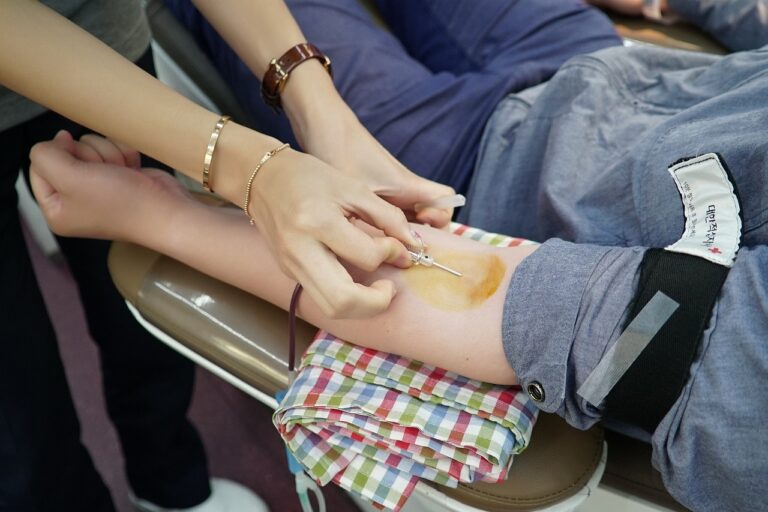Side-Lying Nursing for Co-Sleeping Families: Safety and Benefits
Co-sleeping, the practice of parents and infants sharing a sleeping space, is a common approach for many families. One technique used in co-sleeping is side-lying nursing, where the mother lies on her side and nurses the baby. This method offers both safety and benefits for co-sleeping families.
Side-lying nursing promotes bonding between mother and baby, allowing for close physical contact and skin-to-skin interaction. It also facilitates easier nighttime feedings, as the mother can remain lying down and both she and the baby can comfortably drift back to sleep after nursing. Side-lying nursing promotes better sleep for both mother and baby, reducing disruptions and allowing for restful sleep.
Safety measures should be taken when practicing side-lying nursing. Creating a safe sleep environment by removing pillows, blankets, and other potential hazards is crucial. Correct positioning techniques, such as ensuring the baby is aligned with the mother’s body and that the mother supports the baby’s head and neck, should be followed. Furthermore, reducing the risk of Sudden Infant Death Syndrome (SIDS) is important, and guidelines for safe co-sleeping should be implemented.
By understanding the benefits of side-lying nursing and following safety guidelines, co-sleeping families can enjoy a nurturing and safe sleeping arrangement that promotes a strong bond between mother and baby while ensuring a restful night’s sleep for both.
Key takeaway:
- Side-Lying Nursing promotes bonding between mother and baby: This nursing position allows for close physical contact between the mother and baby, enhancing their emotional connection.
- Easier nighttime feedings: Side-Lying Nursing enables mothers to breastfeed in a lying position, making nighttime feedings more convenient and comfortable.
- Promotes better sleep for both mother and baby: With Side-Lying Nursing, mothers and babies can rest more comfortably, increasing the quality and duration of their sleep.
What is Co-Sleeping?
Co-sleeping is a practice embraced by many families, but what exactly does it entail? In this section, we’ll delve into the world of co-sleeping and explore its different types. From bed-sharing to side-lying nursing, we’ll uncover the various ways in which families choose to sleep together. So, whether you’re new to co-sleeping or curious to learn more, join us on this journey to understand the ins and outs of this popular parenting practice.
The Different Types of Co-Sleeping
- Bed-sharing: This is when the baby sleeps in the same bed as the parents. It involves the baby sleeping on the same surface as the parents, with minimal barriers between them.
- Room-sharing: In this type of co-sleeping, the baby sleeps in close proximity to the parents but on a separate sleep surface. The baby may have their own crib or bassinet placed next to the parents’ bed.
- Side-car arrangement: This involves attaching a crib or bassinet to the side of the parents’ bed, creating a safe and separate sleeping space for the baby while still allowing easy access for breastfeeding or comforting.
- Floor mattress: Some families choose to place a mattress on the floor or a low platform, where both parents and baby can sleep alongside each other. This allows for ease of breastfeeding and closeness without the need for separate sleep spaces.
- Cosleeper bassinet: This is a separate sleep surface that is attached to the parents’ bed, providing a safe and secure space for the baby while still allowing for close proximity and easy access for nighttime feedings.
When considering co-sleeping arrangements, it is important to prioritize safety and ensure that the chosen method is suitable for both the parents and the baby. Each family may have different preferences and needs, so it is essential to choose a co-sleeping type that promotes a safe and comfortable sleep environment while maintaining closeness and bonding between the parents and the baby.
The Benefits of Side-Lying Nursing for Co-Sleeping Families
Discover the incredible benefits of side-lying nursing for co-sleeping families! From promoting a strong bond between mother and baby to facilitating easier nighttime feedings, this approach to feeding offers a myriad of advantages. Plus, it’s not just the baby who benefits – side-lying nursing also promotes better sleep for both mother and baby. So, let’s dive into the wonders of this nurturing technique and explore how it can enhance the breastfeeding experience for co-sleeping families.
Promotes Bonding between Mother and Baby
One of the key benefits of side-lying nursing in co-sleeping families is that it promotes bonding between mother and baby. This position allows for close physical contact and skin-to-skin contact, which is vital for building a strong emotional connection. The physical closeness during side-lying nursing promotes the release of oxytocin, also known as the “love hormone,” in both the mother and baby, enhancing feelings of trust and attachment.
Through side-lying nursing, the mother can easily cradle and cuddle her baby, creating a nurturing and comforting environment. This physical closeness fosters a sense of security and safety for the baby, which in turn promotes relaxation and a stronger bond with the mother.
In addition, side-lying nursing allows for uninterrupted eye contact, allowing the mother to respond to her baby’s cues and emotions more effectively. It also provides opportunities for gentle touch, which can have a calming effect on the baby. This intimate and gentle interaction during side-lying nursing enhances the emotional connection between mother and baby.
Promoting bonding between mother and baby is crucial for establishing a strong foundation of trust and attachment. Side-lying nursing in co-sleeping families offers a natural and nurturing approach to breastfeeding, facilitating the emotional connection between mother and baby.
Fact: Skin-to-skin contact during breastfeeding not only promotes bonding between mother and baby but also has numerous physiological benefits. It helps regulate the baby’s body temperature, stabilizes heart rate and breathing, and even enhances breastfeeding success.
Easier Nighttime Feedings
-
Side-lying nursing allows for easier nighttime feedings. This position provides a more comfortable feeding position during the nighttime.
-
The relaxed position of lying on your side can help both the mother and baby to feel more at ease, promoting easier nighttime feedings. It creates a calm and peaceful feeding experience.
-
With side-lying nursing, there is no need for the mother to sit up or support the baby’s weight, making nighttime feedings less physically tiring for the mother.
-
This position also allows for a longer feeding duration as the mother can rest while still providing nourishment to the baby. It makes nighttime feedings easier.
-
Side-lying nursing can help to minimize disruptions to sleep, as the mother can quickly and easily respond to the baby’s hunger cues without fully waking up. It contributes to easier nighttime feedings.
-
Babies tend to fall back asleep more easily after nighttime feedings in a side-lying position, reducing the overall disturbance to their sleep. It facilitates easier nighttime feedings.
In order to ensure easier nighttime feedings and a comfortable side-lying nursing experience, it is important to have the right support. Here are some suggestions:
– Use a firm mattress with a clean and fitted sheet to provide a safe sleeping surface.
– Keep pillows within reach to support your head, neck, and back as needed for easier nighttime feedings.
– Use a breastfeeding pillow or rolled-up blanket to support the baby’s body and ensure a proper latch during nighttime feedings.
– Experiment with different positions and pillows to find what works best for you and your baby during nighttime feedings.
– Communicate with your healthcare provider or a lactation consultant if you have any questions or concerns regarding easier nighttime feedings.
Remember, every mother-baby pair is unique, so it may take some trial and error to find the most comfortable feeding position. Trust your instincts and listen to your baby’s cues to create a nurturing and peaceful feeding environment.
Promotes Better Sleep for Both Mother and Baby
Promoting better sleep for both mother and baby is one of the significant benefits that side-lying nursing for co-sleeping families offers.
1. Side-lying nursing enables the mother to comfortably breastfeed while lying down, reducing the necessity to sit up or leave the bed during nighttime feedings. This promotes better sleep for both mother and baby.
2. By maintaining a lying position, both mother and baby can easily return to sleep after a feeding without fully waking up or disrupting their sleep cycles. This contributes to better sleep quality for both of them.
3. Side-lying nursing also fosters improved sleep for the baby, as they are more likely to fall asleep at the breast and remain settled throughout the night.
4. The close proximity of mother and baby during side-lying nursing creates a sense of security and relaxation, leading to better quality sleep for both.
5. Research has demonstrated that co-sleeping families who practice side-lying nursing experience longer uninterrupted sleep periods, resulting in enhanced overall sleep patterns.
Pro tip: To ensure a more restful sleep, it is important to establish a safe sleep environment by removing any potential hazards, such as loose blankets or pillows, and ensuring a supportive and comfortable mattress.
Safety Measures for Side-Lying Nursing
When it comes to side-lying nursing, ensuring safety is of utmost importance. In this section, we’ll explore crucial safety measures that co-sleeping families should consider. Discover tips and techniques for creating a safe sleep environment, mastering the positioning techniques for side-lying nursing, and reducing the risk of SIDS. By following these guidelines, you and your little one can enjoy the benefits of side-lying nursing while maintaining a secure and peaceful sleep experience.
Creating a Safe Sleep Environment
When it comes to creating a safe sleep environment, it is crucial for both the mother and the baby during side-lying nursing and co-sleeping.
- Choosing a firm mattress is essential to provide the baby with a firm surface to lie on, reducing the risk of suffocation and promoting safe sleep.
- Removing pillows and blankets from the baby’s sleep area is important to prevent accidental suffocation.
- Ensuring proper room temperature between 68-72 degrees Fahrenheit helps prevent overheating or chilling.
- Using a breathable crib bumper is recommended if using a crib, as it prevents the baby from getting stuck between the slats.
- Keeping the sleep space clutter-free by removing unnecessary items reduces the risk of accidents and creates a safe and soothing environment.
Suggestions to create a safe sleep environment include using a sleep sack instead of loose blankets, avoiding the use of sleep positioners or wedges, and placing the baby to sleep on their back to reduce the risk of Sudden Infant Death Syndrome (SIDS).
Positioning Techniques for Side-Lying Nursing
- Positioning Techniques for Side-Lying Nursing: When practicing side-lying nursing, it is crucial to align the mother and baby’s bodies properly. The mother should lie on her side, facing the baby, with their bodies parallel to each other. This alignment helps ensure comfort and ease during breastfeeding.
- Supporting the baby’s head: To maintain a proper latch and prevent strain on the baby’s neck, it is important to support the baby’s head with a pillow or folded blanket. This helps elevate the baby’s head to a level that aligns with the mother’s breast.
- Positioning the breast: The mother can use her free hand to support her breast and guide it towards the baby’s mouth. By positioning the breast correctly, the baby can easily latch onto the nipple and feed effectively.
- Using additional support: Some mothers find it helpful to use additional support, such as a nursing pillow or rolled-up blanket, to provide extra comfort and stability for both the mother and baby during side-lying nursing.
- Trial and error: Finding the most comfortable and effective positioning techniques for side-lying nursing may require some trial and error. Every mother and baby duo is unique, so experimenting with different positions and supports can help find the optimal setup for successful side-lying nursing.
By implementing these Positioning Techniques for Side-Lying Nursing, mothers can ensure a comfortable and effective breastfeeding experience for both themselves and their babies.
Reducing the Risk of SIDS
To reduce the risk of SIDS (Sudden Infant Death Syndrome) while practicing side-lying nursing, certain measures can be taken.
1. Ensure a safe sleep environment: It is important to create a safe sleeping space for the baby. This includes a firm mattress, fitted sheet, and no pillows or soft bedding.
2. Positioning techniques: Position the baby on their back to sleep and ensure that their head and face are clear of obstructions. Avoid placing the baby in a position where they are at risk of rolling onto their stomach.
3. Avoid smoking and exposure to secondhand smoke: Smoking increases the risk of SIDS, so it is crucial to keep the baby’s environment smoke-free.
4. Follow temperature guidelines: Keep the baby’s sleeping area at a comfortable temperature. Overheating is a risk factor for SIDS, so avoid using excessive blankets or clothing.
5. Breastfeed if possible: Breastfeeding has been shown to reduce the risk of SIDS. If breastfeeding, side-lying nursing can be beneficial for both mother and baby.
By following these safety measures, the risk of SIDS can be reduced while practicing side-lying nursing. It is important for parents to be aware of and implement these guidelines to ensure the safety and well-being of their baby.
Co-Sleeping Safety Guidelines
Co-sleeping can be a wonderful bonding experience for families, but ensuring safety is paramount. In this section, we’ll explore the essential co-sleeping safety guidelines for both mothers and babies. We’ll uncover practical tips and key considerations to promote a secure sleeping environment. From understanding the proper positioning during side-lying nursing to implementing safe bed-sharing practices, this guide will equip you with the knowledge to create a nurturing and secure sleep space for your family.
Guidelines for Mothers
- Ensure that your mattress is firm and flat, providing a safe surface for your baby to sleep on.
- Avoid using soft bedding, such as pillows, blankets, or stuffed animals, in your bed as they can pose a suffocation risk for your baby.
- Position yourself in a way that allows your baby to have easy access to your breast while lying on their side.
- Support your baby’s head and neck with one hand while they are nursing to ensure their airway remains open and clear.
- Keep your bed free from any hazards or objects that could potentially cause harm to your baby, such as loose cords or heavy blankets.
- Stay awake and alert while side-lying nursing to monitor your baby and ensure their safety throughout the feeding.
In the 1900s, side-lying nursing became a popular practice among co-sleeping families. Mothers found this position to be convenient and comfortable, allowing them to breastfeed their infants while lying down. It was believed that side-lying nursing promoted bonding between mother and baby, as well as facilitated easier nighttime feedings. Guidelines for mothers were established to ensure the safety of mothers and infants during this practice, emphasizing the importance of creating a safe sleep environment and maintaining vigilance while nursing. Over the years, these guidelines have evolved to include recommendations such as using a firm mattress, avoiding soft bedding, and keeping the bed free from hazards. By adhering to these guidelines, mothers can safely and comfortably engage in side-lying nursing, fostering a nurturing and secure environment for both themselves and their babies.
Guidelines for Babies
Babies have specific guidelines for their safety during side-lying nursing and co-sleeping. These guidelines, known as guidelines for babies, aim to minimize the risk of accidents and promote better sleep for both the baby and mother.
|
Guideline |
Description |
|
1. Firm mattress |
Use a firm mattress in the crib or co-sleeping area to prevent suffocation or entrapment. |
|
2. Remove pillows and blankets |
Remove pillows, blankets, stuffed animals, or any soft bedding from the sleep environment to prevent suffocation hazards. |
|
3. Keep baby close |
Ensure the baby is placed close to the mother’s side for easy access during nursing and to monitor the baby’s breathing. |
|
4. Avoid bed-sharing on soft surfaces |
Avoid bed-sharing on couches, armchairs, or waterbeds, as these can increase the risk of suffocation or accidents. |
|
5. Dress baby appropriately |
Dress the baby in appropriate clothing for the room temperature to prevent overheating or becoming too cold. |
|
6. No smoking |
Avoid smoking in the house or near the baby, as it increases the risk of Sudden Infant Death Syndrome (SIDS). |
Following these guidelines ensures a safe and comfortable sleep environment for babies during side-lying nursing and co-sleeping. Remember to consult with a healthcare professional for personalized advice based on your baby’s specific needs.
In a historical context, guidelines for baby safety during side-lying nursing and co-sleeping have evolved over time to prioritize the well-being of infants. Researchers and experts have studied the risks associated with co-sleeping and have developed evidence-based guidelines to reduce those risks. By adhering to these guidelines, parents can provide a safe and nurturing environment for their babies while enjoying the benefits of side-lying nursing and co-sleeping.
Frequently Asked Questions
Is side-lying nursing a safe position for co-sleeping families?
Yes, side-lying nursing is considered safe for co-sleeping families when certain safety guidelines are followed. It is important to sleep on a firm mattress, have a mesh guard rail on the side of the bed, and ensure that anyone in the bed is aware of the baby’s presence. Breastfeeding mothers who meet certain criteria, such as being non-smokers, sober, and breastfeeding, are considered low risk for bedsharing.
What are the benefits of side-lying nursing for breastfeeding mothers?
The side-lying position for breastfeeding offers several benefits to nursing mothers. It allows them to rest or nap while feeding their baby, promoting better sleep for sleep-deprived new moms. It is a comfortable position that provides support for the mother’s back. Additionally, it is beneficial for daytime naps, helps cope with cluster feeding, and is useful for women with large breasts or who find sitting difficult.
How does side-lying nursing affect the latch of the baby?
Side-lying nursing can help support the baby’s latch by allowing them to lie facing the mother with their belly to her belly. This position promotes closeness and cuddles while breastfeeding, creating an in-tune connection between the mother and baby. It is important to seek help from a qualified breastfeeding supporter, such as lactation consultants or an LLL leader, if struggling with achieving a proper latch.
Can side-lying nursing cause back pain for the mother?
Side-lying nursing can actually reduce the risk of back pain for the mother. It provides a relaxing feeling of being supported by the mattress and allows the mother to maintain a comfortable reclining position while breastfeeding. However, if a mother experiences back pain, it is advisable to seek assistance from a healthcare professional or a qualified breastfeeding supporter to ensure proper positioning and support.
What are the safety recommendations for side-lying nursing?
To ensure safe side-lying nursing, it is recommended to sleep on a firm mattress, have a mesh guard rail on the side of the bed, and be aware of the baby’s presence while sleeping. It is important to follow the safety guidelines provided by organizations such as the Lullaby Trust and the American Academy of Pediatrics. For more specific safety concerns or individual situations, it is advisable to consult with healthcare professionals or qualified breastfeeding supporters.
How does side-lying nursing benefit both breastfeeding and sleep?
Side-lying nursing benefits both breastfeeding and sleep. Breastfeeding has been found to reduce the risk of Sudden Infant Death Syndrome (SIDS), and side-lying nursing allows mothers to breastfeed more comfortably, particularly during night-time feeds. It promotes a relaxed and deep sleep for both the mother and baby, making night-time parenting easier. Side-lying nursing also allows nursing mothers to get more sleep at night, helping to combat sleep deprivation commonly experienced by new moms.










